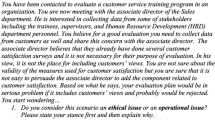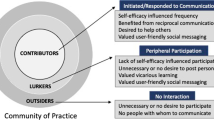Abstract
This study aims to extend a previous work on the role of peer facilitation of asynchronous online discussions. Specifically, in this paper I report three cases that examine students’ preference for peer or instructor facilitation of online discussion forums, as well as their respective reasons for it. These three cases involved the following samples: (a) full-time undergraduates (n = 39), (b) full-time postgraduate diploma students (n = 65), and (c) practicing professionals in training settings (n = 64). Overall, the findings of the three cases suggested that most students irrespective of student samples still preferred an instructor to peer facilitation when it comes to online discussions, despite the reported benefits of peer facilitators in the literature. Cross-comparison of the three cases revealed the following reasons why instructor facilitation is preferred: (a) to prevent the discussion from going off track, (b) to resolve conflicts in the discussion, (c) to provide information particularly when the topic of discussion is new, and (d) to motivate the discussion when students’ participation wanes. On the other hand, peer facilitation is preferred: (a) when the participants desire greater freedom in voicing their own views, (b) when the participants desire greater ownership in determining the direction of the discussion, and (c) when the participants want actual hands-on-facilitation-experience. Implications of the findings are discussed.
Similar content being viewed by others
References
Arend, B. (2009). Encouraging critical thinking in online threaded discussions. The Journal of Educators Online, 6(1). Retrieved on February 15, 2012 from http://www.thejeo.com/Archives/Volume6Number1/Arendpaper.pdf.
Baran, E., & Correia, A-P. (2009). Student-led facilitation strategies in online discussions. Distance Education, 30(3), 339–361.
Baxter Magolda, M. B. (1992). Knowing and reasoning in college: Gender-related patterns in students’ intellectual development. San Francisco: Jossey-Bass.
Beaudin, B. P. (1999). Keeping online asynchronous discussions on topic. J Asynchronous Learn Netw, 3(2), 41–53.
Berge, Z.L. (1995). Facilitating Computer Conferencing: Recommendations from the Field. Educational Technology, 35(1), 22–30.
Brick, J., & Louie, G. (1984). Language and culture–Vietnam: Background notes for teachers in the adult migrant education program. Sydney: Adult Migrant Education Service.
Cheung, W. S., & Hew, K. F. (2005). Factors affecting learners’ satisfaction on the use of asynchronous online discussion in a hypermedia design environment. J Southeast Asian Educ, 5(1&2), 56–70.
Cheung, W. S., & Hew, K. F. (2010). Asynchronous online discussion: instructor facilitation vs. peer facilitation. In C.H. Steel, M.J. Keppell, P. Gerbic & S. Housego (Eds.), Curriculum, technology & transformation for an unknown future. Proceedings ascilite Sydney 2010 (pp.179-183).
Cifuentes, L., Murphy, K. L., Segur, R., & Kodali, S. (1997). Design considerations for computer conferences. J Res Comput Educ, 30(2), 177–201.
Coetzee D., Fox, A., Hearst, M.A., & Hartmann, B. (2014). Should your MOOC forum use a reputation system. In Proc. conference on Computer supported cooperative work & social computing, (pp. 1176-1187). ACM Press.
Corbin, J. & Strauss, A.C. (2007). Basics of qualitative research: techniques and procedures for developing grounded theory. Sage Publications, Inc.
Correia, A. P., & Baran, E. (2010). Lessons learned on facilitating asynchronous discussions for online learning. Educacao, Formacao & Tecnologias, 3(1), 59–67.
Correia, A. P., & Davis, N. E. (2007). The design of collaboration in the virtual classroom. In M. Simonson (Ed.), 30th Annual Proceedings of Selected Papers on the Practice of Educational Communications and Technology (pp. 84–87). Bloomington: Association for Educational Communications and Technology.
Dillenbourg, P. (1999). Introduction: What do you mean by ‘collaborative learning?’ In P. Dillenbourg (Ed.), Collaborative learning: cognitive and computational approaches (pp. 1–19). Amsterdam: Pergamon Elsevier Science.
Dysthe, O. (2002). The learning potential of a web-mediated discussion in a university course. Stud High Educ, 27(3), 339–352.
Ertmer, P. A., Richardson, J. C., Belland, B., Camin, D., Connolly, P., Coulthard, G., et al. (2007). Using peer feedback to enhance the quality of student online postings: an exploratory study. Journal of Computer Mediated Communication, 12(2), 412–433. doi:10.1111/j.1083-6101.2007.00331.x.
Goodyear, P., Salmon, G., Spector, J. M., Steeples, C., & Tickner, S. (2001). Competences for online teaching: a special report. Educ Technol Res Dev, 49(1), 65–72.
Hara, N., Shachaf, P., & Hew, K. F. (2010). Cross-cultural analysis of the Wikipedia community. J Am Soc Inf Sci Technol, 61(10), 2097–2108.
Helsing, D., Drago-Severson, E., & Kegan, R. (2004). Applying constructive-developmental theories of adult development to ABE and ESOL practices. In J. Comings, B. Garner, & C. Smith (Eds.), Review of Adult Learning and Literacy, Volume 4 (pp. 157–197). Routledge.
Hew, K. F., & Cheung, W. S. (2008). Attracting student participation in asynchronous online discussions: a case study of peer facilitation. Comput Educ, 51, 1111–1124.
Hew, K. F., Cheung, W. S., & Ng, C. S. L. (2010). Student contribution in asynchronous online discussion: a review of the research and empirical exploration. Instr Sci, 38(6), 571–606.
Hew, K. F., Liu, S., Martinez, R., Bonk, C., & Lee, J. Y. (2004). Online education evaluation: what should we evaluate? The Proceedings of the Association for Educational Communications and Technology (pp. 243–246). Chicago, IL: Association for Educational Commnications and Technology.
Hewitt, J. (2005). Toward an understanding of how threads die in asynchronous computer conferences. J Learn Sci, 14(4), 567–589.
Hofstede, G. H. (1984). Culture’s Consequences: International Differences in Workrelated Values. Beverly Hills, CA.: Sage Publications.
Hofstede, G. H. (1991). Cultures and Organizations: Software of the Mind. London: McGraw-Hill.
Hiltz. R. S. (1988). Learning in a virtual classroom. Final evaluation report 25, Newark, N.J.: Computerized Conferencing and Communications Centre.
Jonassen, D. H. (1997). Instructional design models for well-structured and ill-structured problem solving learning outcomes. Educ Technol Res Dev, 45(1), 65–94.
Klemm, W. R. (1998). Eight ways to get students more engaged in online conferences. T.H.E. Journal, 26(1), 62–64.
Lang, D. (2000). Critical thinking in web courses. Syllabus, 9, 20–24.
Light, P., Nesbitt, E., Light, V., & White, S. (2000). Variety is the spice of life: student use of CMC in the context of campus-based study. Comput Educ, 34(3), 257–267.
Martinez, M. (2001). Key design considerations for personalized learning on the web. Educ Technol Soc, 4(1), 26–40.
Mazzolini, M., & Maddison, S. (2007). When to jump in: The role of the instructor in online discussion forums. Computers & Education, 49, 193–213.
McCauley, C. D., Drath, W. H., Palus, C. J., O’Connor, P. M. G., & Baker, B. A. (2006). The use of constructive-developmental theory to advance the understanding of leadership. Leadersh Q, 17, 634–653.
O’ Grady, G. K. (2001). Maximising the potential of computer mediated discussion: guidelines for facilitation. Centre for Development of Teaching and Learning (CDTL) Brief, 4(4). Retrieved on 1 Sep 2011 from http://www.cdtl.nus.sg/Brief/v4n4/sec3.asp.
Palincsar, A. S., & Herrenkohl, L. R. (2002). Designing collaborative learning contexts. Theory Into Pract, 41(1), 26–32.
Palmer, S., Holt, D., & Bray, S. (2008). Does the discussion help? The impact of a formally assessed online discussion on final student results. Br J Educ Technol, 39(5), 847–858.
Paulsen, M.F. (1995). Moderating educational computer conferences. In Z.L. Berge and M.P. Collins (Eds.), Computer mediated communication and the online classroom: (pp. 81-89). Vol. 3. Distance Learning. Cresskill, NJ Hampton Press, Inc.
Pearson, J. (1999). Electronic networking in initial teacher education: is a virtual faculty of education possible? Comput Educ, 32(3), 221–238.
Poole, D. M. (2000). Student participation in a discussion-oriented online course: a case study. J Res Comput Educ, 33(2), 162–177.
Richardson, J. C., & Swan, K. (2003). Examining social presence in online courses in relation to students’ perceived learning and satisfaction. J Asynchronous Learn Netw, 7(1), 68–88.
Riffe, D., Lacy, S., & Fico, F. G. (1998). Analyzing Media Messages: Using Quantitative Content Analysis in Research. Mahwah, NJ: Lawrence Erlbaum Associates.
Romiszowski, A., & Mason, R. (2004). Computer-Mediated Communication. In D. Jonassen (Ed.), Handbook of Research on Educational Communications and Technology (pp. 397–431). Mahwah, NJ: Lawrence Erlbaum Associates, Publishers.
Rourke, L., & Anderson, T. (2002). Using peer teams to lead online discussions. Journal of Interactive Media in Education, 1. Retrieved on August 31, 2011 from http://jime.open.ac.uk/article/2002-1/80.
Salmon, G. (2004). E-moderating: The key to teaching and learning online. Taylor & Francis Group.
Seo, K. K. (2007). Utilizing peer moderating in online discussions: addressing the controversy between teacher moderation and nonmoderation. Am J Distance Educ, 21(1), 21–36.
Strijbos, J. W., Martens, R. L., Prins, F. J., & Jochems, W. M. G. (2006). Content analysis: what are they talking about? Comput Educ, 46, 29–48.
Sweetman, K. (2012). In Asia, power gets in the way. Harvard Business Review Blog Network. Retrieved on April 20, 2014 from http://blogs.hbr.org/2012/04/in-asia-power-gets-in-the-way/.
Tu, C.-H. (2001). How Chinese perceive social presence: an examination of interaction in online learning environment. Educ Media Int, 38(1), 45–60.
Westwood, R., Chan, A., & Linstead, S. (2004). Theorizing Chinese employment relations comparatively: exchange, reciprocity and the moral economy. Asia Pac J Manag, 21(3), 365–389.
Winiecki, D. J., & Chyung, Y. (1998). Keeping the thread: helping distance education students and instructors keep track of asynchronous discussions. In Proceedings of the 14th Annual Conference on Distance Teaching & Learning (Vol. 98, pp. 451–460). Madison, WI: University of Wisconsin-Madison.
Wise, A., Chang, J., Duffy, T., & del Valle, R. (2004). The effects of teacher social presence on student satisfaction, engagement, and learning. J Educ Comput Res, 31(3), 247–271.
Yeh, H.-T., & Lahman, M. (2007). Pre-service teachers’ perceptions of asynchronous online discussion on Blackboard. Qual Rep, 12(4), 680–704.
Yin, R. K. (2003). Case study research: Design and methods (3rd ed.): Sage Publications Inc.
Yukselturk, E. (2010). An investigation of factors affecting student participation level in an online discussion forum. The Turkish Online Journal of Educational Technology, 9(2). Retrieved on August 11, 2011 from http://tojet.net/articles/923.pdf.
Zhao, N., & McDougall, D. (2005). Cultural factors affecting Chinese students’ participation in asynchronous online learning. In G. Richards (Ed.), Proceedings of World Conference on E-learning in Corporate, Government, Healthcare, and Higher Education 2005 (pp. 2723–2729). Chesapeake, VA: AACE.
Author information
Authors and Affiliations
Corresponding author
Rights and permissions
About this article
Cite this article
Hew, K.F. Student perceptions of peer versus instructor facilitation of asynchronous online discussions: further findings from three cases. Instr Sci 43, 19–38 (2015). https://doi.org/10.1007/s11251-014-9329-2
Received:
Accepted:
Published:
Issue Date:
DOI: https://doi.org/10.1007/s11251-014-9329-2




